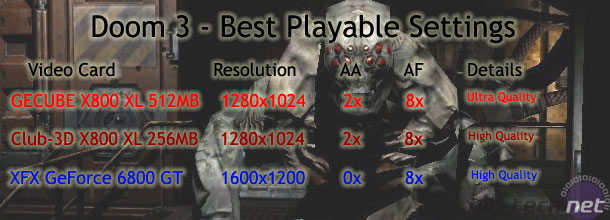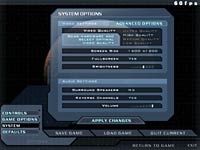Doom 3
Publisher: ActivisionWe are using the full retail version of Doom 3 patched to version 1.1 and we used a section of the "Caverns" level to do a manual run through for the purposes of this comparison. Anti-Aliasing and Anisotropic Filtering were configured from inside the game, and thus we've left the drivers set to "Application Controlled".
Due to the darkness of Doom 3, we find that increasing the resolution has greater image quality benefits than applying AA to a lower resolution.
Below is a table of the best-playable settings that we found best for each video card configuration. In this title, we found that 25 to 30 frames per second minimum and a target of 52 frames per second (or higher) for the average frame rate delivered smooth and very playable game play.

We found that the GECUBE Radeon X800 XL 512MB was capable of a smooth gaming experience at 1280x1024 2xAA 8xAF with Ultra Quality details, while the Club-3D Radeon X800 XL 256MB delivered smooth frame rates at the same settings with High Quality details. The difference between High Quality and Ultra Quality details is negligible, as id Software did a great job with the texture compression for the High Quality mode - the difference certainly didn't warrant the additional cost of the 512MB part.
The GeForce 6800 GT was the top performer in this title - we were able to attain smooth game play at 1600x1200 0xAA 8xAF with High Quality details. The GeForce 6800 GT was generally smoother than both Radeon X800 XL's too, with both higher minimum and average frame rates.

MSI MPG Velox 100R Chassis Review
October 14 2021 | 15:04








Want to comment? Please log in.